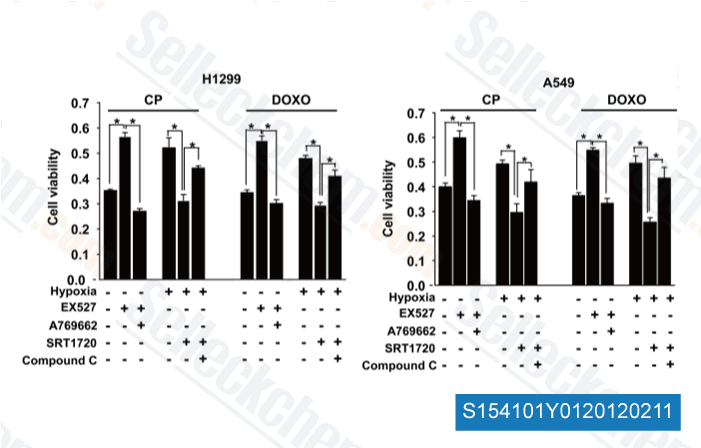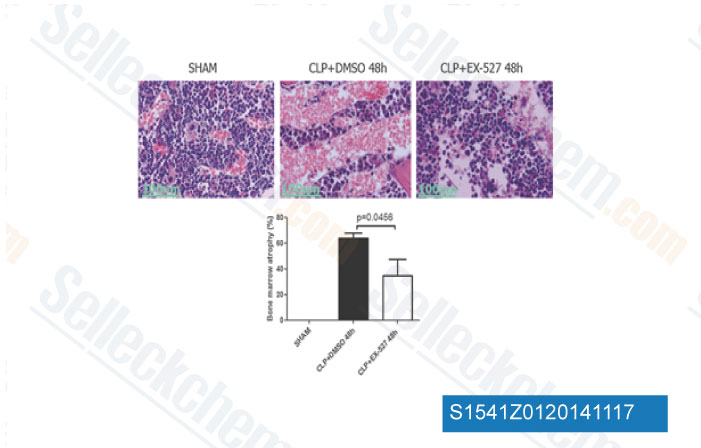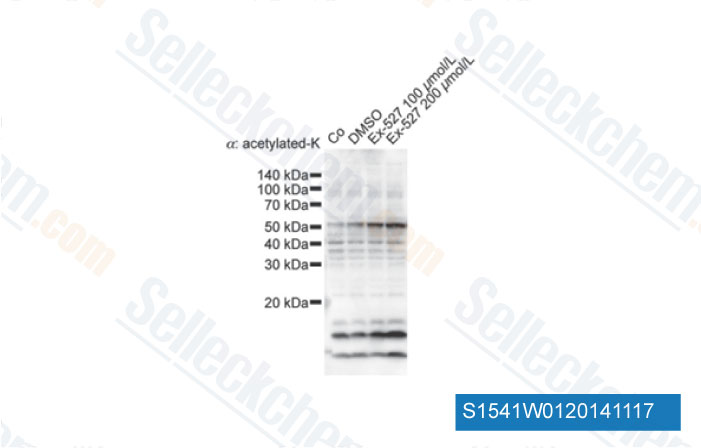|
Toll Free: (877) 796-6397 -- USA and Canada only -- |
Fax: +1-832-582-8590 Orders: +1-832-582-8158 |
Tech Support: +1-832-582-8158 Ext:3 Please provide your Order Number in the email. |
Technical Data
| Formula | C13H13ClN2O |
|||
| Molecular Weight | 248.71 | CAS No. | 49843-98-3 | |
| Solubility (25°C)* | In vitro | DMSO | 50 mg/mL (201.03 mM) | |
| Ethanol | 18 mg/mL (72.37 mM) | |||
| Water | Insoluble | |||
|
* <1 mg/ml means slightly soluble or insoluble. * Please note that Selleck tests the solubility of all compounds in-house, and the actual solubility may differ slightly from published values. This is normal and is due to slight batch-to-batch variations. * Room temperature shipping (Stability testing shows this product can be shipped without any cooling measures.) |
||||
Preparing Stock Solutions
Biological Activity
| Description | Selisistat (EX 527, SEN0014196) is a potent and selective SIRT1 inhibitor with IC50 of 38 nM in a cell-free assay, exhibits >200-fold selectivity against SIRT2 and SIRT3. Phase 2. | ||
|---|---|---|---|
| Targets |
|
||
| In vitro | EX 527 exhibits potently inhibitory effect against SIRT1 deacetylase activity in a concentration-dependent manner with an IC50 of 38 nM, displays much lower activity against SIRT2 and SIRT3 with IC50 values of 19.6 μM and 48.7 μM, respectively. EX 527 does not inhibit SIRT4-7 and class I/II HDAC activity at concentrations up to 100 μM. EX-527 alone (1 μM) has no detectable effect on the acetylation of p53 lysine 382 in NCI-H460 cells. EX-527 significantly increases the amount of acetylated p53 in NCI-H460 cells, human mammary epithelial cells, U-2 OS and MCF-7 cells subjected to genotoxic agents Hydrogen peroxide, which is more effective than that caused by Nicotinamide (5 mM). But surprisingly EX 527 does not result in detectable effects on p53-controled gene expression, cell survival, or cell proliferation. [1] EX 527 causes a 90% increase in cell number of HCT116 cells after 7 days in the condition of 0.1% serum but not 10% serum, suggesting that SIRT1 is a significant regulator of cell proliferation during growth factor deprivation conditions. [2] EX 527 abrogates resveratrol effects on glucose responses, and prevents resveratrol-induced up-regulation of Glut2, glucokinase, Pdx-1, and Tfam in INS-1E Cells, due to the opposite effect of EX 527 and resveratrol on SIRT1 deacetylase activity. [3] |
||
| In vivo | Administration of EX 527 (~10 μg) to rats increases hypothalamic acetyl-p53 levels by inhibiting hypothalamic SIRT1 activity. Co-administration of EX 527 with ghrelin markedly blunts the orexigenic action of ghrelin by decreasing the pAMPK levels, increasing the ACC levels, and abolishing the higher expression of the transcription factors FoxO1, pCREB, and Bsx and the neuropeptides NPY and AgRP in the hypothalamic arcuate nucleus. [4] |
||
| Features | Greater potency, specificity, stability, and lower toxicity than other inhibitors of SIRT1 catalytic activity identified to date. |
Protocol (from reference)
| Kinase Assay: |
|
|---|---|
| Cell Assay: |
|
| Animal Study: |
|
References
Customer Product Validation

-
Data from [Data independently produced by J Pineal Res, 2014, 57(2), 228-38]

-
Data from [Cancer Res, 2014, 74(1), 298-308]

-
Data from [Data independently produced by J Trauma Acute Care Surg, 2014, 10.1097/TA.0347]

-
Data from [Data independently produced by Dev Growth Differ, 2014, 56(6), 460-8]
Selleck's Selisistat (EX 527) has been cited by 317 publications
| Ethyl Lactate Ameliorates Hepatic Steatosis and Acute-on-Chronic Liver Injury in Alcohol-Associated Liver Disease by Inducing Fibroblast Growth Factor 21 [ Adv Sci (Weinh), 2025, 12(5):e2409516] | PubMed: 39661730 |
| Suppression of FOXO1 activity by SIRT1-mediated deacetylation weakening the intratumoral androgen autocrine function in glioblastoma [ Cancer Gene Ther, 2025, 32(3):343-354] | PubMed: 40075208 |
| Lithocholic acid binds TULP3 to activate sirtuins and AMPK to slow down ageing [ Nature, 2024, 10.1038/s41586-024-08348-2] | PubMed: 39695235 |
| Genetic determinants of micronucleus formation in vivo [ Nature, 2024, 627(8002):130-136] | PubMed: 38355793 |
| Genetic determinants of micronucleus formation in vivo [ Nature, 2024, 10.1038/s41586-023-07009-0] | PubMed: 38355793 |
| Single-cell NAD(H) levels predict clonal lymphocyte expansion dynamics [ Sci Immunol, 2024, 9(93):eadj7238] | PubMed: 38489349 |
| SIRT1 maintains bone homeostasis by regulating osteoblast glycolysis through GOT1 [ Cell Mol Life Sci, 2024, 81(1):204] | PubMed: 38700532 |
| Inhibition SIRT1 to regulate FOXP3 or RORγt can restore the balance of Treg/Th17 axis in ulcerative colitis and enhance the anti-inflammatory effect of moxibustion [ Front Immunol, 2024, 15:1525469] | PubMed: 39867884 |
| Amodiaquine ameliorates stress-induced premature cellular senescence via promoting SIRT1-mediated HR repair [ Cell Death Discov, 2024, 10(1):434] | PubMed: 39394181 |
| Deferasirox Causes Leukaemia Cell Death through Nrf2-Induced Ferroptosis [ Antioxidants (Basel), 2024, 13(4)424] | PubMed: 38671872 |
RETURN POLICY
Selleck Chemical’s Unconditional Return Policy ensures a smooth online shopping experience for our customers. If you are in any way unsatisfied with your purchase, you may return any item(s) within 7 days of receiving it. In the event of product quality issues, either protocol related or product related problems, you may return any item(s) within 365 days from the original purchase date. Please follow the instructions below when returning products.
SHIPPING AND STORAGE
Selleck products are transported at room temperature. If you receive the product at room temperature, please rest assured, the Selleck Quality Inspection Department has conducted experiments to verify that the normal temperature placement of one month will not affect the biological activity of powder products. After collecting, please store the product according to the requirements described in the datasheet. Most Selleck products are stable under the recommended conditions.
NOT FOR HUMAN, VETERINARY DIAGNOSTIC OR THERAPEUTIC USE.
